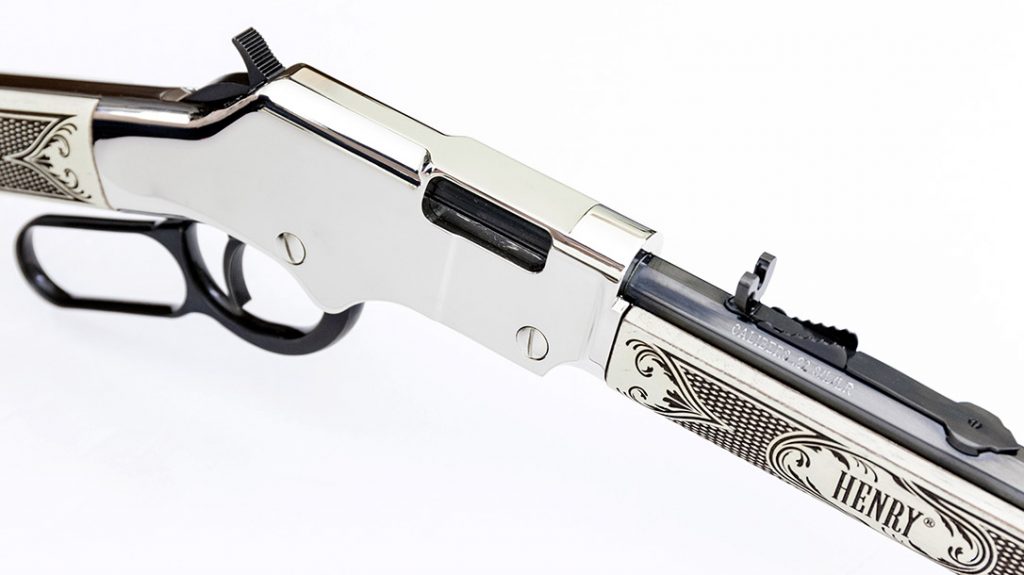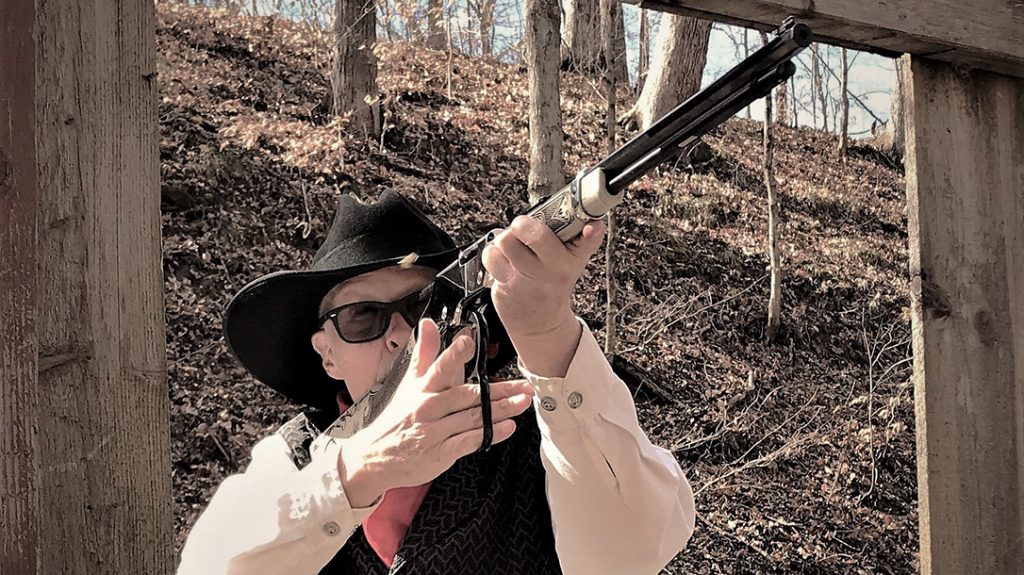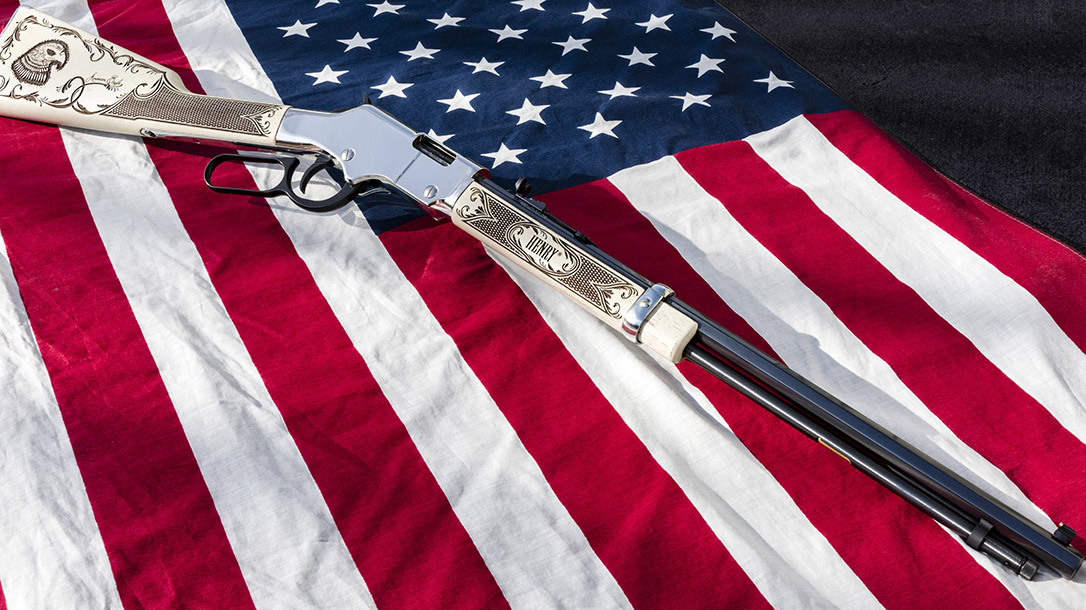For the most part, Henry Repeating Arms has taken over the title of commemorative lever-action rifle-maker. If you look at its catalog or website, you’ll see what I mean. The company offers at least 40 such rifles and carbines, including rimfire and centerfire models. But every single one is still quite affordable. These “themed” firearms can represent an organization or event that has meaning to you without costing an arm and a leg.
Henry American Eagle
Just before the 2019 NRA show, Henry added a new commemorative model to its lineup. What could be more appropriate in these trying times than an American Eagle version of the popular Golden Boy lever-action .22?
Advertisement — Continue Reading Below
Instant Classic
Six years after the signing of the Declaration of Independence, our Founding Fathers decided, in 1782, that the symbol of our new nation would be the majestic American bald eagle. Its imposing appearance, strength and perseverance make for a proud emblem of the United States and its role as the world’s foremost protector of freedom.
To capture the grandeur of our national symbol, the Henry American Eagle rifle is built on the Golden Boy platform with a 20-inch octagonal barrel featuring a 1-in-16-inch twist rate. The rifle’s overall length is 38.5 inches, and it weighs 6.75 pounds unloaded. The receiver cover, barrel band and buttplate are all nickel-plated and given a mirror polish. The rifle’s American walnut furniture features a finish not found on any other Henry models and closely mimics the look of ivory.
First, the walnut receives multiple layers of primers and ivory color, which are sanded down between applications to highlight the wood grain and achieve a natural look. The ivory-colored wood is then deeply engraved with aggressive checkering, leafy vine scrollwork and the head of a bald eagle. After engraving, the wood is finished with a fixative to protect the stock’s color. In contrast, the barrel, trigger and lever have a polished blue finish while the magazine tube has a brushed appearance.
Advertisement — Continue Reading Below
Classic Rimfire Repeater

Like Henry’s Classic and Golden Boy lever actions, the American Eagle is chambered for .22 Short, Long and Long Rifle (LR) cartridges. The magazine tube will hold 15 rounds of .22 LR ammo and 20 rounds of .22 Short. Cartridges are inserted through a slot in the magazine tube after the inner brass tube has been unlocked and pulled forward. The cartridge follower is of blaze orange plastic. Other commonalities include a brass bead front and a fully adjustable, semi-buckhorn rear sight with a white diamond insert. Both sights are affixed to the barrel via dovetail cuts. There is no accommodation for mounting a peep sight or optics on the receiver.
Empty cases eject from a port on the right side of the receiver. There’s no manual safety other than the hammer’s first “click” or quarter-cock position. The hammer spur is serrated, and on my test rifle, the trigger pull was crisp and weighed between 4.5 and 5 pounds. The action was also velvety smooth—another Henry hallmark—and the fit and finish were above average.
Advertisement — Continue Reading Below
If you’re a collector, you will most likely unbox this Henry rifle and place it among the others on your display rack or in your gun vault. But if you’re like me, you’ll more likely admire the finish and décor, and then think about getting it out to the range to see if it shoots as well as it looks.
Burning Powder
I wanted to see how the Henry American Eagle would perform with both name-brand American .22 LR cartridges and some foreign-made, budget-priced fodder. My domestic selections included 40-grain loads from Remington and Winchester with factory-listed velocities of 1,255 fps. I also chose an Aguila load from Mexico and Armscor Precision rounds from the Philippines. Rimfire rifles and handguns are notoriously picky when it comes to ammunition, so I figured it would be interesting to see which load the Henry preferred.
When it hit the range, it was breezy, partly cloudy and a bit chilly. My first task was evaluating the Henry’s accuracy potential. I used a wooden bench and sandbags to support the rifle and fire three 5-shot groups with each type of ammunition. Since I was using iron sights and most Cowboy Action Shooting events aren’t long-range affairs, I kept my targets at 25 yards. However, to make them seem a little farther away, I used a few reduced-size bullseyes from HD Targets. These black bullseyes are 8 inches in diameter with blaze orange 9- and X-rings. Bullet strikes on the target are outlined with a yellow halo, making them easier to see.
Advertisement — Continue Reading Below
Despite the wind chill and gusts, my best five-shot group measured 0.78 inches with the Armscor 36-grain hollow points. Second place went to the Winchester 40-grain Super-X load, which created a 1.08-inch cluster. Right away, I noticed that almost all of my shots were slightly left of center, but I decided against adjusting the rear sight. The brass bead front sight, when held on the dead center of the target, also obscured the orange aiming point. However, the nice, crisp trigger pull certainly contributed to the rifle’s great groups. You can see the rest of the results in the performance table.

Fast & Furious
With the accuracy testing done, I grabbed some ammo and went back behind the berm to ring some steel. I filled the Henry’s tubular magazine with .22 LR cartridges and fired at a number of targets off-hand, including falling bottle-shaped plates and fixed steel targets farther out on the side of a hill. The distances were anywhere from 20 to 35 yards. I shot rapidly at the falling bottles, left to right, and made up my own courses of fire with the larger, steel targets farther out. As long as I did my job, the targets fell or rang. The Henry ran flawlessly. I didn’t experience any hiccups whatsoever.
Advertisement — Continue Reading Below
Going back to the regular part of the range, I threw a yellow Caldwell Duramax Self-Healing Target Ball out about 10 yards and, with a magazine full of mixed ammo, let fly from an off-hand, standing position, running the ball up the range toward the berm. Each hit made the ball roll various directions and distances depending on where it was hit. It was so fun, I had to empty quite a few magazines. The bullets didn’t do much damage to the ball, and I found one .22-caliber pill actually stuck in the high-impact plastic.
Final Thoughts
As a final test, I loaded up the magazine tube again and, without aiming, shot at the ball starting at about 5 yards from a hip-level position, working the lever and pulling the trigger as quickly as possible. I did this twice, and there were no malfunctions whatsoever. By the way, I did hit the ball most of the time, just shooting instinctively. I’d done this kind of thing as a kid with a lever-action BB gun, shooting untold thousands of copper-plated steel BBs at empty soda cans. After a day at the range with the Henry American Eagle, I can safely say that it shoots as great as it looks and helps maintains the status of the lever-action rifle as America’s gun! For more information, visit henryusa.com.
Henry American Eagle Specs
- Caliber: .22 Short/Long/LR
- Barrel: 20 inches
- Overall Length: 38.5 inches
- Overall Weight: 6.75 pounds (empty)
- Stock: American walnut
- Sights: Brass bead front, semi-buckhorn rear
- Action: Lever
- Finish: Blued, nickel-plated
- Overall Capacity: 20+1 (.22 Short), 15+1 (.22 LR)
- MSRP: $990
Performance: HENRY AMERICAN EAGLE
Load: Velocity, Accuracy
Advertisement — Continue Reading Below
- Aguila 40 Super Extra LRN: 1,255, 1.14
- Armscor Precision 38 HP: 1,247, 0.78
- Remington 40 Golden Bullet: 1,255, 1.35
- Winchester 40 Super-X: 1,255, 1.08
Bullet weight measured in grains, velocity in fps by chronograph and accuracy in inches for best five-shot groups at 25 yards.
This article is from the spring 2020 issue of Guns of the Old West magazine. Grab your copy at OutdoorGroupStore.com.























